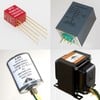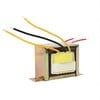Help with Voltage and Potential Transformers specifications:
General Specifications
Back to Top
|
|
| ||
| Type / Applications | |||
| Your choices are... | |||
| Commercial | The commercial class transformers are well suited for low power current monitoring applications. | ||
| ANSI Class | The ANSI metering class transformers are units intended for power monitoring applications where high accuracy and minimum phase angle error are required. | ||
| Multi-ratio | These transformers have several outputs. Each output corresponds to a different transformer ratio. | ||
| Three-phase | The transformer is used in three-phase systems to measure current or voltage. | ||
| Split Core | Split core current transformers are designed to provide a low cost method to monitoring electrical current. A unique hinge and locking snap allows attachment without interrupting the current-carrying wire. | ||
| Toroidal / Window | Toroidal or donut transformers have no internal primary winding as such. The primary is the conductor in which the current is to be monitored, and is not an integral part of the transformer. The primary conductor is simply placed through the window of the current transformer. The core in this type is a band of magnetic grade steel concentrically wound upon it. This is an extremely efficient core design that has no breaks or gaps in the magnetic path. While other types of core designs may produce relative high levels of audible noise, (approximately 30-70 DB's) the toroidal core rarely produces an audible noise level. | ||
| Wound Primary | Wound primary current transformers have primary windings that usually consist of more that one turn. Wound primary transformers have an internal primary winding and have no windows for the primary conductor to pass through. They have an advantage in that the designer can make units with low current ratios that therefore have better accuracy and burden capabilities. The primary of the transformer is inserted in series with the conductor that is being monitored. For this reason there is some hesitation to use wound primary transformers even though they may be the most effective way to achieve the desired performance, especially for the low current ratio requirements. The wound primary types may be designed using the toroidal cores because of its excellent efficiency. The wound primary type is more common in the higher (greater than 600V class) voltage class current transformers as it makes the problems of the higher voltages easier for the design engineer to cope with, while keeping the design as cost effective as possible. | ||
| Bar | Bar current transformers are toroidal transformers with a bus bar permanently inserted through the window of the toroid. The bus bar serves as the primary conductor. Bar transformers are inserted directly into the circuit that they will be used to monitor. It is a common error to refer to wound primary transformers as bar transformers because the primary connections are made to bus bars. In the wound type, bus bars are a means of connection and not continuous bars | ||
| PC Mount | PC mount transformers offer a small footprint for the design engineer looking to measure sensor current or voltage on a computer board. Some applications for which these transformers are used include sensing current overload, ground fault detection, metering, isolated current feed-back signal in switch mode power supplies, motor current load / overload, lighting, switch controls, ultra-sound current, high resolution sonar current and isolated bi-directional current sensor with full wave bridge. | ||
| Under / Over Current Sensing | Transformer used to measure under and/or over current. | ||
| Noncontact Device | Noncontact current transformers can accurately measure current waveforms without coming into electrical contact with the circuit. | ||
| Other | Other unlisted types / applications. | ||
| Search Logic: | All products with ANY of the selected attributes will be returned as matches. Leaving all boxes unchecked will not limit the search criteria for this question; products with all attribute options will be returned as matches. | ||
Features
Back to Top
|
|
| ||
| Waterproof | The transformer has a waterproof case. | ||
| Search Logic: | "Required" and "Must Not Have" criteria limit returned matches as specified. Products with optional attributes will be returned for either choice. | ||
| Military Standard | The transformer satisfies military standards or specifications (MIL-SPEC). | ||
| Search Logic: | "Required" and "Must Not Have" criteria limit returned matches as specified. Products with optional attributes will be returned for either choice. | ||
| Meets ANSI C12 Standards | ANSI standards for electric metering. | ||
| Search Logic: | "Required" and "Must Not Have" criteria limit returned matches as specified. Products with optional attributes will be returned for either choice. | ||
| Meets IEC 1036 Standards | IEC electrical metering standards. | ||
| Search Logic: | "Required" and "Must Not Have" criteria limit returned matches as specified. Products with optional attributes will be returned for either choice. | ||
| Outdoor Use | The transformer can be used outdoors. | ||
| Search Logic: | "Required" and "Must Not Have" criteria limit returned matches as specified. Products with optional attributes will be returned for either choice. | ||
Performance
Back to Top
|
|
| ||
| Accuracy | Accuracy is the degree of uncertainly which the measured current (secondary) value agrees with the ideal value. Accuracy class of instrument transformers is defined by the requirements of ANSI standard number C57.13. | ||
| Search Logic: | All matching products will have a value less than or equal to the specified value. | ||
| Operating Temperature: | This is the full-required range of ambient operating temperature. | ||
| Search Logic: | User may specify either, both, or neither of the limits in a "From - To" range; when both are specified, matching products will cover entire range. Products returned as matches will meet all specified criteria. | ||
| Primary Voltage (Ratio) Range | This is the rated voltage of the system where voltage must be stepped down for measurement and/or protective purposes. | ||
| Search Logic: | User may specify either, both, or neither of the "At Least" and "No More Than" values. Products returned as matches will meet all specified criteria. | ||
| Secondary Voltage (Ratio) Range | This is the voltage at which the meters and protective devices connected to the secondary circuit of the voltage transformer operate. | ||
| Search Logic: | User may specify either, both, or neither of the "At Least" and "No More Than" values. Products returned as matches will meet all specified criteria. | ||
| Burden | In current or potential transformers, burden in VA is the maximum load the transformer can support while operating within its accuracy rating. Volt-Ampere (VA) is the product of the RMS voltage applied to a circuit and the RMS current, in amperes, flowing through it. | ||
| Search Logic: | User may specify either, both, or neither of the "At Least" and "No More Than" values. Products returned as matches will meet all specified criteria. | ||
| Insulation Voltage | The maximum insulation that the transformer provides when connected. | ||
| Search Logic: | User may specify either, both, or neither of the "At Least" and "No More Than" values. Products returned as matches will meet all specified criteria. | ||


